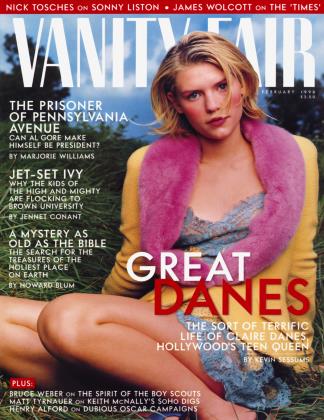Sign In to Your Account
Subscribers have complete access to the archive.
Sign In Not a Subscriber?Join NowJAZZ AGE GIANTS
Magazine artists such as Ralph Barton, Miguel Covarrubias, Al Hirschfeld, and Paolo Garretto created a golden era of celebrity caricature in the 1930s. As a show opens at Washington's National Portrait Gallery, JAMES WOLCOTT examines the modern sparkle of their work
The art of celebrity caricature reached its rainbow crest in the 30s, when most American writing was mired in a mood of prison gray. During and after the Depression, American fiction was proletarian in outlook, naturalistic in numbing detail, and hangdog in spirit, its plodding characters driven to extinction by economic determinism. (The Marxist school of criticism was even more leadfooted.) Not all eyes were cast downward, however. As writers wrestled with the fate of Collective Man, artists like Ralph Barton, Miguel Covarrubias, Will Cotton, A1 Hirschfeld, and Paolo Garretto captured and celebrated the physiognomic individuality of the high and mighty in the pages of Vanity Fair and The New Yorker. The aristocracy of achievement had found its fun-house portraitists. Hemingway as Tarzan, Babe Ruth as a Moon Pie baseball, Mae West looking like a royal barge—even lampooned, celebrities remained larger than life, ballooninflated. The playful accentuations and pixie-dust colors of the baubles on display in the National Portrait Gallery's exhibition "Celebrity Caricature in America"—opening in Washington, D.C., this April, with a tie-in book by the show's curator, Wendy Wick Reaves— reflect the heyday between the wars, when the glamour of Broadway lent luster to the Algonquin Round Table group, whose wisecracking wit in turn helped sharpen the tongue of the talkies. The period didn't last long, and yet how well it's lasted. What looked like the temporary sparkle of passing fancy possesses a vigor, focus, and streamlined attack that transcends nostalgia and pops off the page. Like Art Deco and Russian Constructivism, these illustrations remind us of how modern we used to be and, in our dreams of sophistication, still aspire to be.
The airstocracy of achievement had found its fun-house portraitists.
 View Full Issue
View Full Issue


















Subscribers have complete access to the archive.
Sign In Not a Subscriber?Join Now